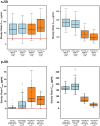Subcutaneous dosing regimens of tocilizumab in children with systemic or polyarticular juvenile idiopathic arthritis
- PMID: 33506875
- PMCID: PMC8487273
- DOI: 10.1093/rheumatology/keab047
Subcutaneous dosing regimens of tocilizumab in children with systemic or polyarticular juvenile idiopathic arthritis
Abstract
Objectives: To determine s.c. tocilizumab (s.c.-TCZ) dosing regimens for systemic JIA (sJIA) and polyarticular JIA (pJIA).
Methods: In two 52-week phase 1 b trials, s.c.-TCZ (162 mg/dose) was administered to sJIA patients every week or every 2 weeks (every 10 days before interim analysis) and to pJIA patients every 2 weeks or every 3 weeks with body weight ≥30 kg or <30 kg, respectively. Primary end points were pharmacokinetics, pharmacodynamics and safety; efficacy was exploratory. Comparisons were made to data from phase 3 trials with i.v. tocilizumab (i.v.-TCZ) in sJIA and pJIA.
Results: Study participants were 51 sJIA patients and 52 pJIA patients aged 1-17 years who received s.c.-TCZ. Steady-state minimum TCZ concentration (Ctrough) >5th percentile of that achieved with i.v.-TCZ was achieved by 49 (96%) sJIA and 52 (100%) pJIA patients. In both populations, pharmacodynamic markers of disease were similar between body weight groups. Improvements in Juvenile Arthritis DAS-71 were comparable between s.c.-TCZ and i.v.-TCZ. By week 52, 53% of sJIA patients and 31% of pJIA patients achieved clinical remission on treatment. Safety was consistent with that of i.v.-TCZ except for injection site reactions, reported by 41.2% and 28.8% of sJIA and pJIA patients, respectively. Infections were reported in 78.4% and 69.2% of patients, respectively. Two sJIA patients died; both deaths were considered to be related to TCZ.
Conclusion: s.c.-TCZ provides exposure and risk/benefit profiles similar to those of i.v.-TCZ. S.c. administration provides an alternative administration route that is more convenient for patients and caregivers and that has potential for in-home use.
Trial registration: ClinicalTrials.gov, http://clinicaltrials.gov, NCT01904292 and NCT01904279.
Keywords: autoinflammatory conditions; biologic therapies; cytokines and inflammatory mediators; inflammation; juvenile idiopathic arthritis.
© The Author(s) 2021. Published by Oxford University Press on behalf of the British Society for Rheumatology.
Figures




Similar articles
-
Long-term efficacy and safety of subcutaneous tocilizumab in clinical trials of polyarticular or systemic juvenile idiopathic arthritis.Rheumatology (Oxford). 2024 Sep 1;63(9):2535-2546. doi: 10.1093/rheumatology/keae180. Rheumatology (Oxford). 2024. PMID: 38552315 Free PMC article. Clinical Trial.
-
Intravenous dosing of tocilizumab in patients younger than two years of age with systemic juvenile idiopathic arthritis: results from an open-label phase 1 clinical trial.Pediatr Rheumatol Online J. 2019 Aug 22;17(1):57. doi: 10.1186/s12969-019-0364-z. Pediatr Rheumatol Online J. 2019. PMID: 31438986 Free PMC article. Clinical Trial.
-
Clinical pharmacology of tocilizumab for the treatment of polyarticular-course juvenile idiopathic arthritis.Expert Rev Clin Pharmacol. 2017 May;10(5):471-482. doi: 10.1080/17512433.2017.1300058. Epub 2017 Mar 15. Expert Rev Clin Pharmacol. 2017. PMID: 28293968 Review.
-
Long-term, interventional, open-label extension study evaluating the safety of tocilizumab treatment in patients with polyarticular-course juvenile idiopathic arthritis from Poland and Russia who completed the global, international CHERISH trial.Clin Rheumatol. 2018 Jul;37(7):1807-1816. doi: 10.1007/s10067-018-4071-9. Epub 2018 Apr 13. Clin Rheumatol. 2018. PMID: 29654485 Free PMC article. Clinical Trial.
-
Safety of tocilizumab in the treatment of juvenile idiopathic arthritis.Expert Opin Drug Saf. 2017 Apr;16(4):493-500. doi: 10.1080/14740338.2017.1303479. Expert Opin Drug Saf. 2017. PMID: 28277841 Review.
Cited by
-
Towards a standardized program of transitional care for adolescents with juvenile idiopathic arthritis for Turkey: a national survey study.Pediatr Rheumatol Online J. 2024 Jan 2;22(1):7. doi: 10.1186/s12969-023-00943-3. Pediatr Rheumatol Online J. 2024. PMID: 38167070 Free PMC article.
-
Systematic Review of Adverse Events of IL-1 and IL-6 Inhibitor Use in Pediatrics.J Pediatr Pharmacol Ther. 2025 Apr;30(2):152-169. doi: 10.5863/1551-6776-30.2.152. Epub 2025 Apr 14. J Pediatr Pharmacol Ther. 2025. PMID: 40717752 Free PMC article.
-
Comparative efficacy and safety of different drugs in patients with systemic juvenile idiopathic arthritis: A systematic review and network meta-analysis.Medicine (Baltimore). 2024 May 3;103(18):e38002. doi: 10.1097/MD.0000000000038002. Medicine (Baltimore). 2024. PMID: 38701278 Free PMC article.
-
Therapeutic and hepatoprotective effect of tocilizumab combined with total glycosides of peony in systemic juvenile idiopathic arthritis.Medicine (Baltimore). 2025 Feb 21;104(8):e41552. doi: 10.1097/MD.0000000000041552. Medicine (Baltimore). 2025. PMID: 39993112 Free PMC article.
-
Adult-Onset Still's Disease (AOSD): Advances in Understanding Pathophysiology, Genetics and Emerging Treatment Options.Drugs. 2024 Mar;84(3):257-274. doi: 10.1007/s40265-024-01993-x. Epub 2024 Mar 5. Drugs. 2024. PMID: 38441807 Free PMC article. Review.
References
-
- Ravelli A, Martini A.. Juvenile idiopathic arthritis. Lancet 2007;369:767–78. - PubMed
-
- Prakken B, Albani S, Martini A.. Juvenile idiopathic arthritis. Lancet 2011;377:2138–49. - PubMed
-
- Martini A, Ravelli A, Avcin T, for the Paediatric Rheumatology International Trials Organization (PRINTO) et al.Toward new classification criteria for juvenile idiopathic arthritis: first steps, Paediatric Rheumatology International Trials Organization International Consensus. J Rheumatol 2019;46:190–7. - PubMed
-
- Guzman J, Oen K, Tucker LB. et al.The outcomes of juvenile idiopathic arthritis in children managed with contemporary treatments: results from the ReACCh-Out cohort. Ann Rheum Dis 2015;74:1854–60. - PubMed
-
- Oen K, Guzman J, Dufault B, the Research in Arthritis in Canadian Children emphasizing Outcomes (ReACCh-Out) investigators et al.Health-related quality of life in an inception cohort of children with juvenile idiopathic arthritis: a longitudinal analysis. Arthritis Care Res 2018;70:134–44. - PubMed
Publication types
MeSH terms
Substances
Associated data
Grants and funding
LinkOut - more resources
Full Text Sources
Other Literature Sources
Medical

